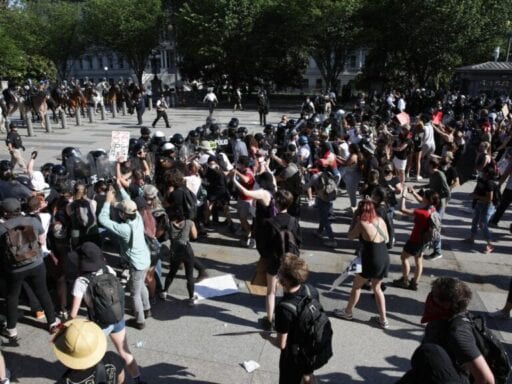It was another night of nationwide protest over George Floyd’s death.
Nationwide protests over police violence after the death of George Floyd continued to escalate Saturday night. At least 25 cities imposed curfews to try to keep protests, some of which became violent, off the streets. States called up their National Guards. In cities around the country, police fired rubber bullets and tear gas. Some protesters threw glass bottles, stones, and bricks.
Floyd died in Minneapolis on Monday after a police officer, who was charged with murder on Friday, pinned Floyd’s neck to the ground with his knee for nearly 9 minutes while Floyd pleaded for air. Across the country, Floyd’s death has become a symbol of police violence and inequality. And the protests are playing out against the backdrop of a pandemic that has disproportionately affected black Americans.
Many protests started out peacefully. But as the night continued, violence erupted from both protestors and police — and in some cases, the police violence was unprovoked, according to reporters on the scene.
A police SUV drove into a crowd of protesters in Brooklyn
Videos widely circulated on social media showed a New York Police Department SUV driving into a crowd of protesters. Mayor Bill de Blasio offered only mild condemation, saying, “It is a troubling video, and I wish they hadn’t done that, but we have to be clear.. they were being surrounded by a violent crowd,” according to Gloria Pazmino, a reporter for NY1, on Twitter.
Here is the overhead… pic.twitter.com/US6Qqhkz3O
— Rob Bennett @ (@rob_bennett) May 31, 2020
Police fired tear gas, rubber bullets, and other projectiles in cities around the country
In Washington, DC, some protesters attempted to scale barricades surrounding the White House. Police fired clouds of tear gas and rubber bullets.
Back in the medic area, protesters are screaming, “it burns!” Volunteer medics are washing out wounds. Offering people milk and water mixed with antacids for their burning throat and eyes. #DC pic.twitter.com/Bx8Nc8S7Xg
— Marissa J. Lang (@Marissa_Jae) May 31, 2020
Police also fired tear gas at protestors in Minneapolis — without provocation in at least one case, according to MSNBC’s Ali Velshi:
WATCH: @AliVelshi reports from Minneapolis as police fire tear gas toward protesters: “There has been no provocation … The police pulled into this intersection unprovoked.” pic.twitter.com/OEUXdPg73O
— MSNBC (@MSNBC) May 31, 2020
In Denver, police fired tear gas as protestors threw fireworks, according to Denver Post reporter Saja Hindi:
Cops responding with A LOT of tear gas. pic.twitter.com/GXYE0JfvHZ
— Saja Hindi (@BySajaHindi) May 31, 2020
The Geneva Convention bans tear gas in international warfare, although it’s explicitly allowed in domestic policing situations; in the short term, it causes painful symptoms, and “we don’t know much about the long-term effects, especially in civilian exposure,” a tear gas expert told Vox in 2014.
Journalists were struck by rubber bullets and arrested
In Minneapolis, a photographer for local news organization WCCO was struck by a rubber bullet, forced onto the ground by police, and arrested, according to the news outlet. Police also fired tear gas at journalists who had identified themselves as media, according to LA Times reporter Molly Hennessy-Fiske:
Minnesota State Patrol just fired tear gas at reporters and photographers at point blank range. pic.twitter.com/r7X6J7LKo8
— Molly Hennessy-Fiske (@mollyhf) May 31, 2020
In Brooklyn, police arrested a Huffington Post reporter:
Confirmed that this is @huffpost reporter @letsgomathias getting arrested — I didn’t catch when they first apprehended him but it was incredibly violent. His press badge is clearly visible. pic.twitter.com/ob3FvEzkiK
— Phoebe Leila Barghouty (@PLBarghouty) May 31, 2020
These aren’t the first arrests of journalists during the ongoing protests: CNN’s Omar Jimenez was arrested on live TV earlier in the week.
Author: Libby Nelson
Read More



